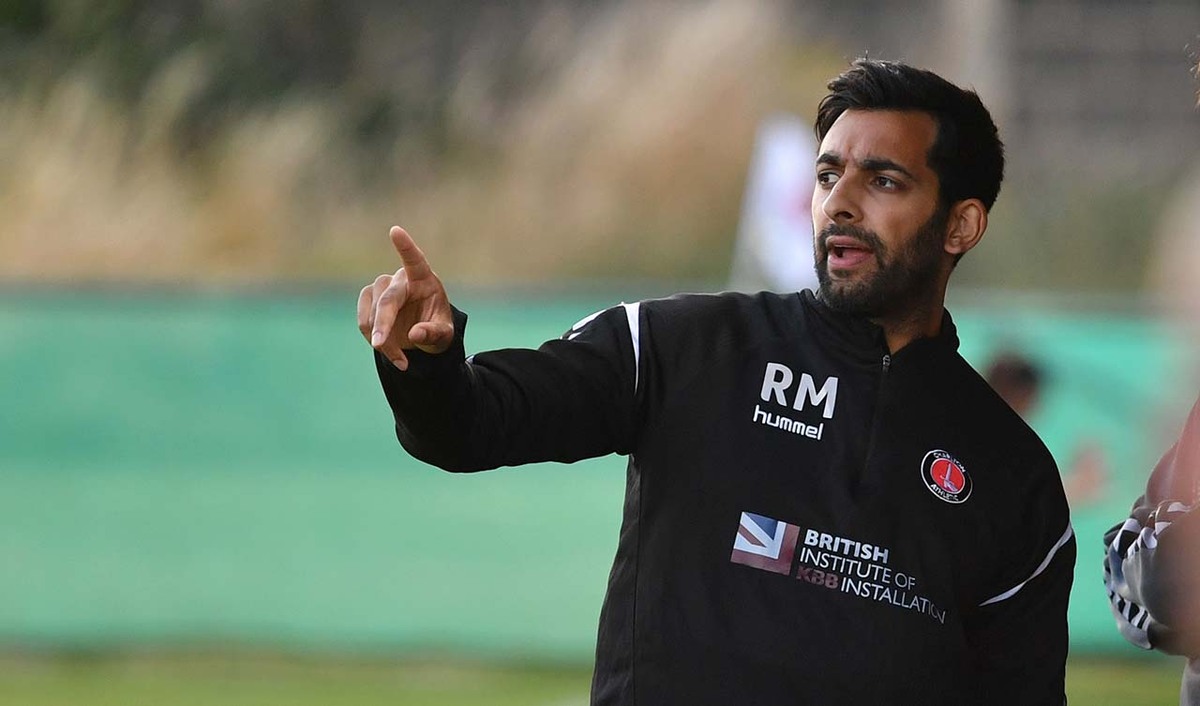




OUR BEST EVER OFFER - SAVE £100/$100
JOIN THE WORLD'S LEADING PROFESSIONAL DEVELOPMENT PROGRAMME
- 12 months membership of Elite Soccer
- Print copy of Elite Player & Coach Development
- Print copy of The Training Ground
Play forward and support
This training session is about creating opportunities to play forward passes into the feet of forward players, or into attacking space. It is also aimed at encouraging quick support play from players behind the pass in order to either offer secure support behind the ball or to join in the attack with runs past the ball.
| Area | Up to three quarters of pitch |
| Equipment | Balls, bibs, cones, 2 mini goals, 2 full size goals |
| No. of Players | 16 players + 2 goalkeepers |
| Session Time |
Break out and score: 20mins, Play forward and score: 20mins, Small-sided game: 20mins |
This training session is about creating opportunities to play forward passes into the feet of forward players, or into attacking space. It is also aimed at encouraging quick support play from players behind the pass in order to either offer secure support behind the ball or to join in the attack with runs past the ball.
The session focuses on some key themes: creating the right spaces to pass forwards and through opponents; the detail of the pass forwards and the detail of the forward’s receiving skills; the quality of the supporting runs; and the creation of an end product.
The best thing about this session is that it is always creating 1v1 duals, so the level of competition and energy comes from this. The focus is on forward play and fast support, so it will always create transitions and natural turnovers of possession, which in turn creates great opportunities to also practise the key elements of transition for the defensive players, such as defending when outnumbered, emergency defending, or recovery runs.
There is a clear and simple structure to this training session, so players can understand how the key themes can progress from small areas to a larger practice.
We wouldn’t run this session too often, because we like to have a lot of variety. But generally, we would work on this type of session in the lead up to a game against opponents that may press in midfield and forward areas, which would leave some space to play forward passes into and the space for supporting runs beyond.
BREAK OUT AND SCORE
We set up between the penalty area and the halfway line, divided into two separate lengthwise playing areas. A possession box of 12x15 yards is marked at one end of each area and a mini goal is positioned at the other end of each area. We’re using 16 outfield players, split into two attacking teams of five and two defending teams of three. We play a 4v2 possession game in each possession box, with the attacking team passing to keep the ball under pressure from the two defenders. After the attacking team has made three or more passes, they can play forward into the one attacker in the main area, who is marked by a lone defender. The attacker and defender go 1v1 towards the mini goal. The attacker tries to score and the defender must try to clear the ball out of play, as shown [1].
1
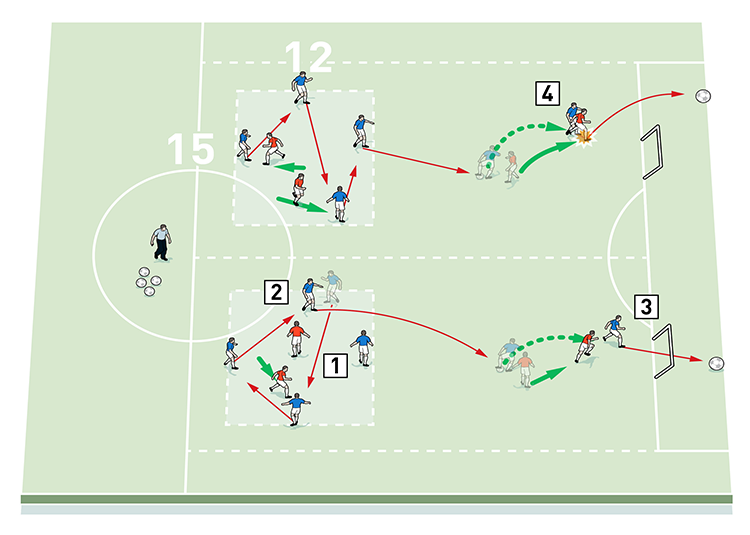
2. After the attacking team has made three passes, they can play into the sole attacker in the main area
3. The attacker takes on the defender 1v1 and tries to score in the mini goal
4. If the defender wins possession, the ball should be cleared out of play
The players rotate roles every two minutes or after every attack. We play for 20 minutes.
PLAY FORWARD AND SCORE
We now extend the length of the area to the other side of the centre circle to create one large
playing area, with a possession box of 30x44 yards marked out at one end and the two mini goal remaining at the other end.
We’re using 16 outfield players, split into two teams of eight. We play a 6v6 in the large possession box, with two players from each team in the main area. The team that gains possession must pass the ball under pressure until they can create an opportunity to play out to one of their team mates in the main area. The attackers then go 2v2 against the opposition and try to score in one of the mini goals, as shown [2a]. If the two defenders win possession they must try to clear the ball out of play.
2a

2. The defenders should try to win the ball and if they succeed, they clear it out of play
3. The attackers go 2v2 against their opponents and try to score in one of the goals
In the first progression, one or two attacking players are allowed to follow the ball out of the possession box to create an attacking overload, as shown [2b].
2b
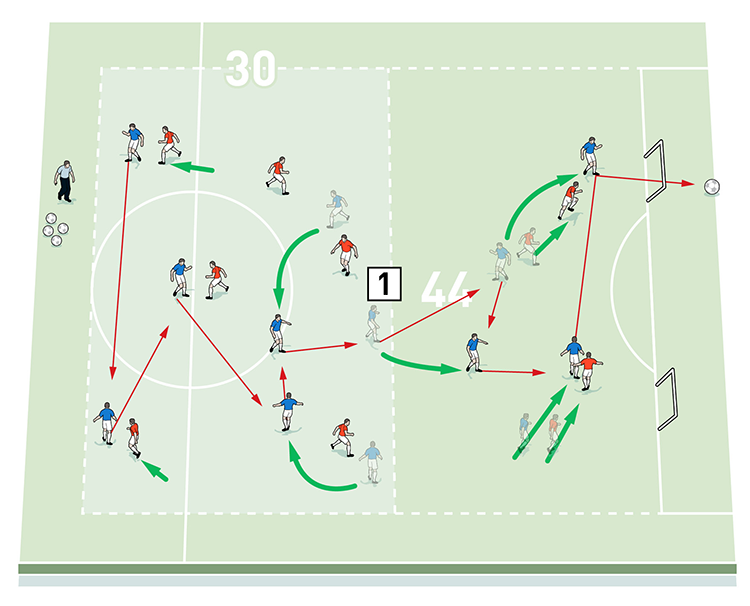
In the second progression, we now allow both a defender and an attacker to follow the ball out of the possession box, making it a 3v3 attack, as shown [2c].
2c
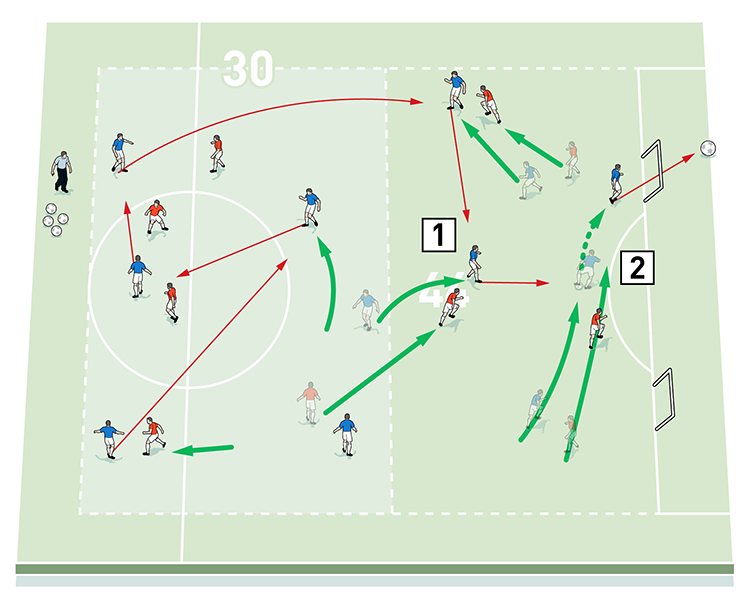
2. This makes it a 3v3 attack
We play this activity for 20 minutes.
SMALL-SIDED GAME
We set up a pitch from one 18-yard line to the other 18-yard line, coned off the width of the penalty area. The playing area is marked into thirds.
We’re using 16 outfield players, split evenly into two teams of eight and we position a goal and a goalkeeper at each end. We play an 8v8 game, as shown [3], with players encouraged to start and restart play in their own positional zones (for instance, midfielders would start in the central zone).
3
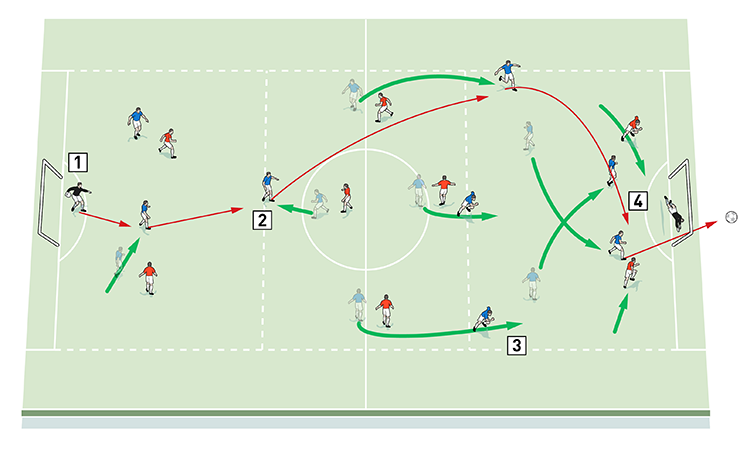
2. Players put into practice what they have learnt in the session. Here a midfielder plays the ball forward
3. The midfielders push up to support the play
4. The forwards make support runs to give the receiving player some attacking options
We ask players to put into practice what they have learnt in the session, but if it’s felt necessary, we can restrict them to operating only in their own positional zones in order to encourage players to play forward.
We can progress this game to allow supporting attacking runs and defensive recovery runs between zones. In the final progression of the game, we would play with free movement and remove all restrictions.
We would play this small-sided game for 20 minutes.
COACHING POINTS
What are the key things to look out for?
We want to see defenders and midfielders making angles to receive, in order to create passing lanes forwards and to draw opposition defenders. They should adopt the correct body shape and ‘feel’ for their marker to encourage them to turn and play forward where possible. The speed of the forward pass is also very important.
We want to see strikers adopting the correct body shape and angle to receive the pass and to see that their first touch is always directed away from pressure.
Making the right kind of supporting runs is important, as is knowing when to receive the ball to feet and when to receive in space.
Strikers should also ‘feel’ for the defender, to encourage them to turn and go 1v1 and not just wait for their supporting players.
What are the typical mistakes players might make and how do I avoid them?
We often see forward players coming too close to the ball to receive. They do this because they are too eager and this makes the space too tight. To solve this, we encourage them to stay high and pin their defender, or we enforce this habit by restricting them to a zone that they must stay inside, because we want to encourage the pass to be made through this space.
Players often try to force the pass forwards or play over the opposition. To remedy this, we need to work on the patience of possession, the movement of support players to try to create forward passing lanes, and work on some specific technical details such as disguised passes and body shape to pass forward, to make it harder to read the forward pass.
Sometimes players make too many run beyond the ball, leaving us exposed and not protected if the forward pass is cut out. So, we will work on specific rules for the number of players to support.
Related Files
Editor's Picks
Attacking transitions
Deep runs in the final third
Using the goalkeeper in build-up play
Intensive boxes drill with goals
Penetrating the final third
Creating and finishing
My philosophy
Pressing initiation
Compact team movement
Coaches' Testimonials

Alan Pardew

Arsène Wenger

Brendan Rodgers

Carlos Carvalhal

José Mourinho

Jürgen Klopp

Pep Guardiola

Roy Hodgson

Sir Alex Ferguson

Steven Gerrard
Coaches' Testimonials

Gerald Kearney, Downtown Las Vegas Soccer Club

Paul Butler, Florida, USA

Rick Shields, Springboro, USA

Tony Green, Pierrefonds Titans, Quebec, Canada
Join the world's leading coaches and managers and discover for yourself one of the best kept secrets in coaching. No other training tool on the planet is written or read by the calibre of names you’ll find in Elite Soccer.
In a recent survey 92% of subscribers said Elite Soccer makes them more confident, 89% said it makes them a more effective coach and 91% said it makes them more inspired.
Get Monthly Inspiration
All the latest techniques and approaches
Since 2010 Elite Soccer has given subscribers exclusive insight into the training ground practices of the world’s best coaches. Published in partnership with the League Managers Association we have unparalleled access to the leading lights in the English leagues, as well as a host of international managers.
Elite Soccer exclusively features sessions written by the coaches themselves. There are no observed sessions and no sessions “in the style of”, just first-hand advice delivered direct to you from the coach.
